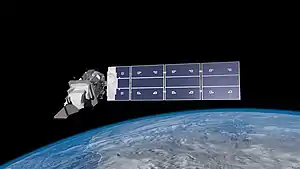 Landsat 9 in orbit | |
| Mission type | Satellite imagery |
|---|---|
| Operator | NASA / USGS |
| COSPAR ID | 2021-088A |
| SATCAT no. | 49260 |
| Website | Landsat 9 |
| Mission duration | 15 years - with fuel (planned)[1] 2 years, 3 months, 17 days (in progress) |
| Spacecraft properties | |
| Spacecraft | Landsat 9 |
| Spacecraft type | Landsat |
| Bus | LEOStar-3 |
| Manufacturer | Northrop Grumman Innovation Systems |
| Launch mass | 2,711 kg (5,977 lb) |
| Dimensions | 4.6 m × 3 m × 3 m (15.1 ft × 9.8 ft × 9.8 ft) |
| Power | 4300 watts |
| Start of mission | |
| Launch date | 27 September 2021, 18:12:00 UTC[1][2] |
| Rocket | Atlas V 401 (AV-092) |
| Launch site | Vandenberg, SLC-3E |
| Contractor | United Launch Alliance |
| Entered service | January 6, 2022 [1] |
| Orbital parameters | |
| Reference system | Geocentric orbit |
| Regime | Sun-synchronous orbit |
| Altitude | 705 km (438 mi) |
| Inclination | 98.2° |
| Period | 99.0 minutes |
| Repeat interval | 16 days |
| Instruments | |
| Operational Land Imager-2 (OLI-2) Thermal Infrared Sensor-2 (TIRS-2) | |
 LANDSAT 9 mission patch | |
Landsat 9 is an Earth observation satellite launched on 27 September 2021 from Space Launch Complex-3E at Vandenberg Space Force Base on an Atlas V 401 launch vehicle.[3] NASA is in charge of building, launching, and testing the satellite, while the United States Geological Survey (USGS) operates the satellite, and manages and distributes the data archive.[4] It is the ninth satellite in the Landsat program, but Landsat 6 failed to reach orbit. The Critical Design Review (CDR) was completed by NASA in April 2018, and Northrop Grumman Innovation Systems (NGIS) was given the go-ahead to manufacture the satellite.[5]
Design
The design and construction of Landsat 9 were assigned by NASA, under a delivery order contract to Orbital ATK, in October 2016. The purchase cost of US$129.9 million is part of a five-year contract between the two entities. The budget that provides for initial work on Landsat 9 also calls for research into less expensive and smaller components for future Landsat hardware.[4]
Landsat 9 will largely replicate the functions of its predecessor Landsat 8. The former will include near-identical copies of remote sensors: the Operational Land Imager (OLI) and the Thermal Infrared Sensor (TIRS) instruments – optical and thermal sensors respectively – that will be designated OLI-2 and TIRS-2;[6] the latter will be upgraded to a risk class B implementation (high priority, high national significance, high complexity)[7] while no changes will be applied to OLI-2.[8]
NASA selected Ball Aerospace & Technologies to provide the OLI-2 instrument through a sole source procurement. OLI-2 will collect data for nine spectral bands with a ground sample distance (GSD) of 30 m for all bands except the panchromatic band, which has a 15 m GSD.[9]
NASA assigned the TIRS-2 instrument as a directed development to Goddard Space Flight Center (GSFC). Design changes to the TIRS-2 are intended to address the stray light and Scene Select Mechanism (SSM) encoder problems experienced with the TIRS on Landsat 8.[6] Testing and assessment of the TIRS-2 demonstrate the stray light magnitude has been reduced to insignificant levels.[10]
Launch
Landsat 9 was launched on 27 September 2021 at 18:12 UTC.[11] This is 4–5 years after the end of Landsat 7's mission design lifetime and near the end of its maximum (fuel supply) lifetime. The Launch Services Program (LSP) at the Kennedy Space Center (KSC) controlled the launch operations, which was conducted from Vandenberg Space Force Base.[12] The launch of Landsat 9 was delayed to September 2021 due to the effects of the COVID-19 pandemic on spacecraft work in Arizona.[3]
Gallery
- Landsat 9 launch, as seen from Lompoc, California, on a cloudy day.
See also
- Sentinel-2B, a comparable satellite operated by the European Space Agency (ESA).
References
- 1 2 3 Costa, Jason (27 September 2021). "Landsat 9 Continues a Legacy of 50 Years". blogs.nasa.gov. NASA. Retrieved 28 September 2021.
- ↑ "NASA and United Launch Alliance Update Landsat 9 Target Launch Date – Kennedy Space Center". blogs.nasa.gov. NASA. 15 September 2021. Retrieved 15 September 2021.
 This article incorporates text from this source, which is in the public domain.
This article incorporates text from this source, which is in the public domain. - 1 2 "Coronavirus delays push back launch of next Landsat to September 2021". Spaceflight Now. 7 September 2020. Retrieved 8 September 2020.
- 1 2 "NASA, USGS Begin Work on Landsat 9 to Continue Land Imaging Legacy". NASA. 16 April 2015. Retrieved 16 April 2015.
 This article incorporates text from this source, which is in the public domain.
This article incorporates text from this source, which is in the public domain. - ↑ "FY 2021 Congressional Justification: Landsat 9 – Schedule Commitments/Key Milestones" (PDF). NASA. 10 February 2020. p. 321. Retrieved 7 May 2020.
 This article incorporates text from this source, which is in the public domain.
This article incorporates text from this source, which is in the public domain. - 1 2 Markham, Brian L.; et al. (September 2016). "Landsat 9: Status and plans". In Butler, James J; Xiong, Xiaoxiong (Jack); Gu, Xingfa (eds.). Earth Observing Systems XXI. Earth Observing Systems XXI. Vol. 9972. p. 6. Bibcode:2016SPIE.9972E..0GM. doi:10.1117/12.2238658. ISBN 9781510603356. S2CID 3929985. 99720G.
- ↑ "Risk Classification for NASA payloads" (PDF). nodis3.gsfc.nasa.gov. Archived from the original (PDF) on 14 April 2021. Retrieved 7 April 2017.
 This article incorporates text from this source, which is in the public domain.
This article incorporates text from this source, which is in the public domain. - ↑ "Landsat 9 Science Instrument Details". Goddard Space Flight Center. NASA. Archived from the original on 7 April 2017. Retrieved 7 May 2020.
 This article incorporates text from this source, which is in the public domain.
This article incorporates text from this source, which is in the public domain. - ↑ "Landsat 9 Instruments". Goddard Space Flight Center. NASA. Retrieved 10 January 2019.
 This article incorporates text from this source, which is in the public domain.
This article incorporates text from this source, which is in the public domain. - ↑ Montanaro, Matthew; et al. (May 2022). "Landsat 9 Thermal Infrared Sensor 2 (TIRS-2) Stray Light Mitigation and Assessment". IEEE Transactions on Geoscience and Remote Sensing. 60: 60, 1–8. Bibcode:2022ITGRS..6077312M. doi:10.1109/TGRS.2022.3177312. S2CID 249032009.
- ↑ "LAUNCH ALERT! We are heading to the West Coast for our next launch. #AtlasV is scheduled to launch #Landsat 9 for @NASA_LSP and @NASA_Landsat next Monday from Vandenberg Space Force Base. Liftoff is 11:12 PDT (14:12 EDT; 18:12 UTC)". Twitter. Retrieved 27 September 2021.
- ↑ Amos, Jonathan (27 September 2021). "Landsat-9: 'Satellite of record' launches to picture Earth". BBC.